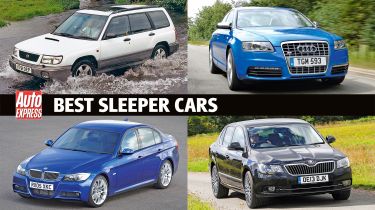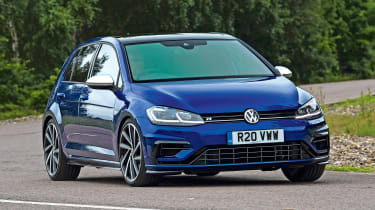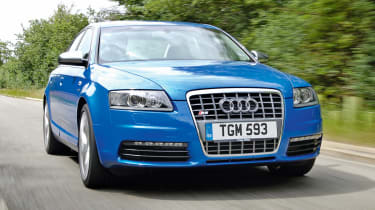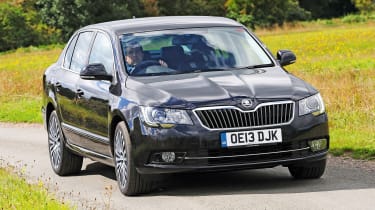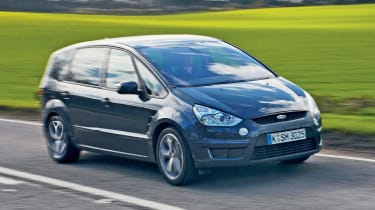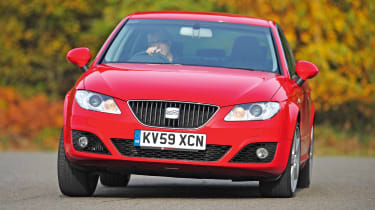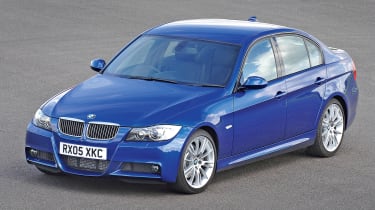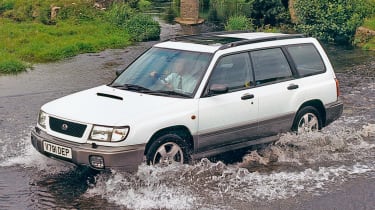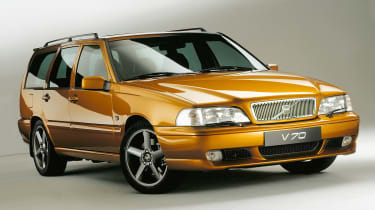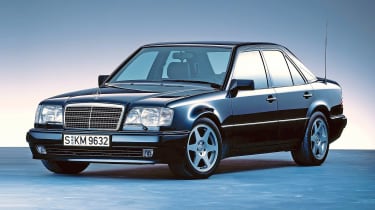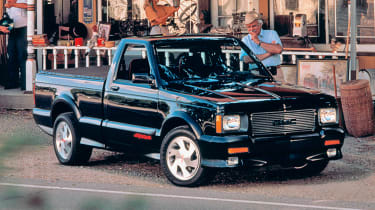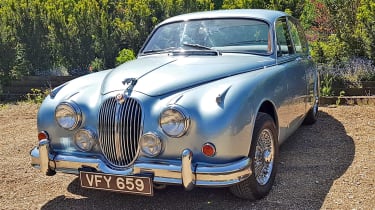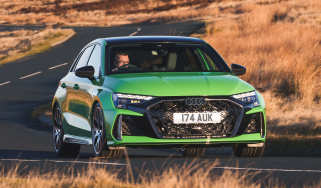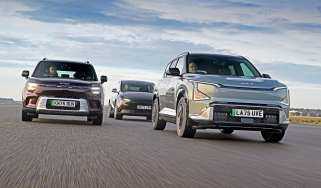Best sleeper cars: used Q cars that are faster than they look
Want to get somewhere fast without drawing attention to yourself? Then you need a sleeper car: an unassuming motor that packs serious punch under the bonnet
Being impressed by the acceleration of another car is always interesting. Because while we may all drive to limits, watching somebody get a serious shift on inevitably provokes a sense of “Did you just see that?”. We expect this sort of performance from certain cars, naturally. Spot a snouty, mid-engined supercar, and you wouldn’t be surprised if the driver hit the accelerator and disappeared into the distance at speed.
But what is more impressive, or at least more surprising, is when you see a car you hadn’t given a second glance to – an anonymous estate, a random hatchback, a dull repmobile – shoot towards the horizon with a change of pace such a vehicle has no right to be capable of, its speed allied to its everyday looks.
Some call these vehicles ‘Q’ cars, others call them ‘sleeper cars’, and they’re simple machines in concept: cars with unobtrusive looks, deliberately coupled with serious performance. We’re not talking about M cars, RS or AMG models here, and the Lotus Carlton or Aston Martin Rapide need not apply. Sleepers, by their nature, fly under the radar – they pack a silent punch. Scroll down below to check out our list of the best sleeper cars money can buy.
Why ‘Q car’ and ‘sleeper car’?
The origins of ‘sleeper car’ and ‘Q car’ have similar roots. Sleepers are enemy agents who blend into a foreign country, waiting to be activated and strike. Q cars take their name from Q ships: warships made to look like merchant vessels, the letter ‘Q’ possibly denoting ‘query’. Whatever the name, these cars always surprise.
Best sleeper cars
Volkswagen Golf R (2012)
It’s easy to argue that the R version of the seventh-generation Golf isn’t a sleeper simply because it has quad exhaust pipes. But in the R’s favour is one simple thing: there are millions of Golfs on the road and, unless you’re counting exhaust tips, it really doesn’t stand out. With 296bhp, four-wheel drive and a sub-five-second 0-62mph time, it takes plenty of talent or a lot more power to keep up with an R on a cross-country route.
Factor in the ‘R’ badge looking similar to VW’s R-Line trim logo, plus the fact there’s an estate version for ultimate stealth, and you’ve got yourself a proper sleeper. The only issue is security, because the Golf R has a bit of a reputation for being desired by those who have absolutely no intention of paying for their own.
Audi S6 V10 (2008)
Whoever thought that putting a V10 engine into an unobtrusive executive saloon was a rational thing to do? Well Audi did exactly that. So while the third-generation S6 looked fairly normal if you ignored the quad exhausts – a subtle S-model trait – it had an absurd engine, and lacked the more overt looks of the E60 BMW M5.
The S6’s V10 came from the Lamborghini Gallardo and, while it was detuned (by almost 100bhp) to 429bhp, 0-62mph took 5.2 seconds, and any power deficit was made up for by the fact that it did without its RS brother’s look-at-me bodykit, justifying its place in our list.
Skoda Superb V6 (2008)
The second-generation Superb brought with it looks that were entirely ‘Skoda’, unlike the VW Passat-aping Mk1. More important, however, was the ability to specify a 3.6-litre V6 engine with four-wheel drive. Offered only with a dual-clutch transmission and in high-end Laurin & Klement or Elegance trims, the V6 Superb could be had for under £25,000 – not bad for a 256bhp sleeper with a 0-62mph time of 6.4 seconds.
Despite the quad exhaust pipes, being a big Skoda meant you were more likely to be mistaken for a taxi driver than someone at the wheel of a performance car. The jury’s out on whether the estate or saloon (which was also a hatchback thanks to the ‘TwinDoor’ boot) is the stealthier choice.
Mazda 6 MPS (2006)
We know Mazda can make sporty cars – the MX-5, RX-7 and RX-8 leave that in no doubt. But the firm’s more practical hatchbacks, SUVs and saloons tend to be resolutely sensible, and often bring relatively sedate performance. So the fact Mazda decided to offer fast MPS versions of the 3 hatchback and 6 saloon should be applauded.
Either car would have fitted into this list – we opted for the 6 MPS only because the 3 MPS had a bonnet scoop – but whatever your tastes, be in no doubt that this is a seriously rapid machine that didn’t shout about its performance. The 6 MPS’s turbocharged 2.3-litre engine made 256bhp, while four-wheel drive meant it had no issue putting its power onto the road – something that its 0-60mph time of 6.6 seconds confirms.
Ford S-MAX 2.5T (2006)
There have been a few fast MPVs over the years, but how about a seven-seat Ford with the five-cylinder engine from a Focus ST? Sounds like the perfect recipe for a sleeper. The S-MAX Mk1 offered great handling, so making it faster was only ever going to be a good idea. While 217bhp and a 0-62mph time of 7.9 seconds is warm-hatch territory today, watching a big MPV hitch up its skirt remains an amusing prospect.
SEAT Exeo 2.0 TSI (2006)
The automotive equivalent of wallpaper paste, the Exeo could hardly be more anonymous, which makes the 197bhp 2.0-litre TSI model a strong contender for the ultimate sleeper. Basically a 2005 Audi A4 with a nose job, the Exeo Sport could be configured with stiffened suspension for no extra cost, while the interior was lifted largely from the then-previous-generation A4 Cabriolet, so build quality and materials were up to snuff.
Performance was strong, with a 0-62mph time of 7.3 seconds, while the handling was predictable. The only issue today is finding one; while we found around 60 Exeos for sale in the classifieds, none of them had the 2.0 TSI engine.
BMW 330d (2005)
Fast diesel cars are well established today, but back in the 2000s such models weren’t so common. It’s no surprise the E90-generation BMW 330d was favoured by the boys in blue, because that car in the rear-view mirror could easily be a 316i.
It was fast and flew neatly under the radar. Rocking up the motorway in a 242bhp (228bhp pre-facelift) and 520Nm 3 Series – ideally one that had been de-badged – was always going to impress. But while the 335d that followed in 2006 was slightly quicker, its later arrival meant it lost some of the element of surprise. The 330d’s 0-62mph time was 5.9 seconds, while mid-range acceleration would shame almost anything out there. And 50mpg was just about possible, if you drove sensibly.
Subaru Forester S Turbo (1997)
It would have been easy to include a subtly quick Subaru Impreza in this list, but the rallying connotations mean Subaru’s saloon is a bit obvious. More justifiable, however, is the Forester Turbo S; it had the same 2.0-litre turbocharged boxer engine as its more illustrious sibling.
And, although it packed 168bhp instead of the 200bhp+ Subaru was giving Imprezas of this era, the Forester S Turbo could crack 0-62mph in less than eight seconds, all the while looking like butter wouldn’t melt in its mouth – assuming you ignored the intercooler bonnet scoop. Add in low sales, permanent four-wheel drive and a boxy shape that meant anyone giving it a passing glance would see a load-lugger, it means that this is a performance car that blends into the background.
Volvo V70 R (1997)
Proving it’s not just crims who can spot a good sleeper, the Volvo V70 R was a hit with traffic cops, who loved its ability to swallow their kit in its huge boot, while also packing enough of a punch to tear down motorways at 150mph. With a 247bhp 2.3-litre turbocharged in-line five, the V70 R wasn’t the first fast Volvo estate, but it put the company firmly on the map for traffic cops.
Civilian owners weren’t averse to the charms of this swift Swede, either, and its power was accompanied by masses of grip, a limited-slip diff, Alcantara seats and climate control. Front and four-wheel drive were available, as was an automatic gearbox, although the auto brought a 10bhp deficit.
Mercedes 500E (1991)
Porsche was on its uppers; Mercedes wanted to put a 5.0-litre V8 in its E-Class to compete with the BMW M5. But Mercedes hadn’t designed the W124 to take such an engine, so it outsourced the project to Porsche. The sports car maker left the car almost untouched aesthetically – no spoilers or multiple exhausts – but had to flare the front wings to fit the engine in.
None of this is obvious to the casual observer and, history aside, the 500E (which became the E 500 in 1994) made 318hp, and was so subtle only those in the know would recognise it.
GMC Syclone (1991)
Fast 4x4s are common today, but the Syclone’s arrival in 1991 brought with it gasps of disbelief. A pick-up truck that could run from 0-60mph in 4.3 seconds still sounds faintly ridiculous, and one can only imagine what people made of it back then.
True, the publicity and shock of its arrival would have removed some of its sleepy nature – as would its red decals. But to anyone on a US interstate who merely glanced at a Syclone, all they would have clocked was a GMC pick-up. Then they would have wondered what happened when the Mitsubishi turbocharger on the 280bhp 4.3-litre V6 spooled up, and the Syclone disappeared off towards the horizon.
Jaguar Mark II 3.8 (1959)
An early Q car, and one that developed an association with ne’er-do-wells, the MkII could be had with 2.4 or 3.4-litre XK straight-six engines, but it was the 3.8-litre that really packed a punch, and its 220bhp output is still respectable today. That this potency was dressed up in a pressed-steel body with all the hallmarks of aristocracy only made it all the more surprising.
Yes, it became recognised as a cad express, and yes, the S-Type that was built alongside it could be had with the same top-spec engine. But the police had a tough time with MkIIs until they got some themselves, and a 0-60mph time of 8.5 seconds remains decent. Plus, seeing a MkII get a move on remains akin to watching a sideboard perform a pirouette.
Which is your favourite car from this list? Let us know in the comments section...

